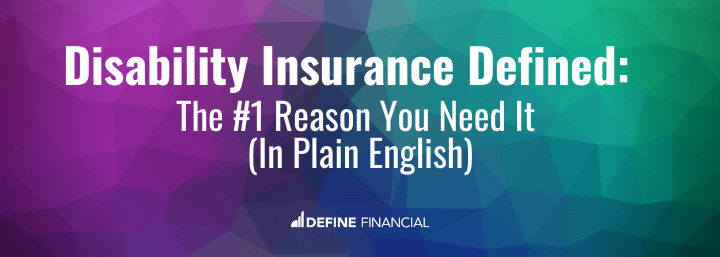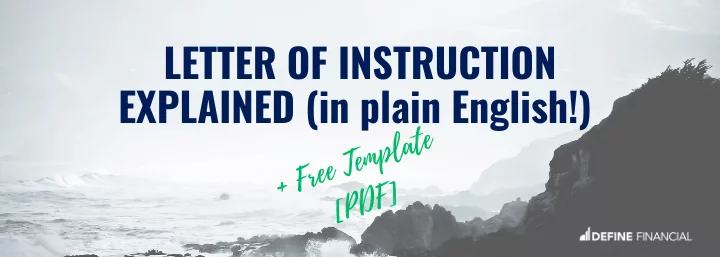
This guide has everything you need to know about disability insurance.
Specifically, I’m sharing a simple definition of disability insurance, who needs it, how to avoid a gap in coverage, and more.
So if you want to protect your income and save money, you’re going to enjoy today’s post.
Before I define disability insurance, let me set the scene for you:
Joe Danger, CPA earns $100,000 a year working at a Big Four accounting firm.
In his free time, Joe likes to practice juggling chainsaws.
During a recent chainsaw-juggling performance, Joe injures his hands. Without any working digits, Joe is no longer able to use the number pad on his keyboard.
He can’t work, and he’s not entitled to his salary!
Pretty unfortunate for Mr. Danger, right?
But he’s not alone.
Even if you’re not into extreme extracurriculars, you could still find yourself in a similar position as Joe: unable to work and not entitled to your salary.
Let’s define disability insurance so you understand what it is and how it works, and more importantly, why you need it.
If you just want the cliff notes, I recommend watching this short video (and by short, I mean less than 90 seconds!)
How Disability Insurance Works
Disability insurance is also referred to as income-replacement insurance. It replaces (a portion of) your income in the event that you are no longer able to work.
Think of it this way: disability insurance is paycheck insurance.
Lose your hands in a chainsaw juggling activity? Not to worry! Disability insurance will replace (a portion of) your paycheck.
Also, if you find yourself too ill to work for months on end, disability insurance can help you make ends meet.
Who Doesn’t Need Disability Insurance (and Why)
Disability insurance replaces your paycheck in the event that you are too ill or injured to work for long periods of time.
So, if you are not looking at a lifetime of employment, disability insurance likely doesn’t make sense.
If one of the following applies to you, you probably don’t need a disability policy:
- Retirees: If you’re retired, you’re not earning a paycheck. It doesn’t make sense to pay for disability insurance to insure something that you don’t have.
- People working now, but on the eve of retirement: If you’re just a few years from retirement, a disability policy may not make sense for you either. Policies can be relatively expensive because the cost of insurance rises as you age. And experiencing a disability at the eve of retirement may simply mean retiring a little earlier than planned.
- Non-working spouses: Disability insurance protects your paycheck. Don’t have a paycheck? You’re in the same boat as retirees: it doesn’t make sense to pay to insure something that doesn’t exist. Save your money.
Why You Need Disability Insurance
For working professionals, disability insurance is one of the most important policies you can own.
Why?
Because it protects the most valuable thing you own: yourself, and your ability to earn more money from working in the future.
Think about it: what’s the value of your car? Your house? Your 401(k)?
Whatever it is, it’s likely a small fraction of your future salaries.
Don’t believe me? Let’s do the math.
Your Annual Salary ($) X # of Years You’ll Be Working
If your annual salary is $100,000 and you’re 30 years out from retirement, you are worth $3,000,000. You should insure that with disability insurance.
Is Your Policy Through Your Company Enough?
Many employers offer disability insurance. Unfortunately, group disability policies (i.e. employer-provided) are usually far from perfect.
They can leave you severely exposed in the event that you’re disabled and can’t work.
To get an idea of what a disability policy may look like in action, let’s return to our fictional character: Joe Danger, CPA.
“Normally, Joe earns $100,000 a year. Since he can’t work, Joe’s employer-provided long-term disability policy pays Joe $40,000/year for two years.”
Joe does receive a long-term disability benefit from his employer. However, the policy only replaces a portion (40%) of his income.
It’s also important to know that employers can offer two different types of disability policies:
- Short-term
- Long-term
Keep reading to learn the differences between the two.
Short-Term Disability Insurance
Short-term disability policies are distinct from long-term disability policies in not only how long the benefits last, but also when you start receiving money.
Consider one real-life example of an employer-provided short-term disability policy:
- Coverage for 11 weeks
- At 66.7% of salary
- 7 days after the disability occurs
There are pros and cons of this coverage, which we’ll explain. But let’s look at the other type of coverage, first: long-term.
Long-Term Disability Insurance
If your employer offers both short and long-term disability (LTD) policies, know that a LTD policy will only kick in after a short-term policy ceases providing benefits.
You’ll likely never receive both short-term and long-term benefits at the same time. That’s because short-term and long-term benefits will rarely overlap.
And, depending upon the specifics of each disability policy, there might even be a lapse in coverage between short-term disability ending and long-term disability benefits beginning.
For example, let’s say long-term disability benefits begin at 26 weeks.
Even if you’re receiving both short and long-term disability policies as an employer benefit, you can still find yourself with a gap in coverage.
That makes a rainy day fund – or about six months of living expenses saved in cash – that much more important.
Choosing Additional LTD Coverage from Your Employer
It is not uncommon for employers to offer employees the opportunity to purchase additional long-term disability coverage.
Think back to our example of Joe and his chainsaws. The base LTD policy provides protection of 40% of Joe’s wages.
This is common.
Employers also sometimes offer employees the chance to purchase an additional 20% or 26 2/3% of coverage.
Therefore, in the event of disability, you may be entitled to up to 66 2/3% of your wages – but only if you opted for additional protection.
So, should you go for the additional protection from your employer’s LTD plan?
To answer that question we need to understand the term “own occupation.”
What Does Own Occupation Mean?
While 66% 2/3 of a person’s salary is considered adequate protection, these employer-provided LTD policies usually have one very large problem: an “own occupation” definition of just two years.
This makes the likelihood of receiving longer-term benefits dubious.
To define “own occupation,” let’s return to our hypothetical story with Joe Danger, CPA:
Joe is no longer able to perform his job as an accountant.
He never purchased the additional coverage to get him to 66 2/3% of his wages.
Fortunately, he is still enrolled in his employer’s base long-term disability policy at no charge.
The benefit kicks in after 180 days, paying Joe 40% of his base wages. Joe collects $40,000/year for two years. (Joe’s base salary is $100,000.)
Two years later, the disability policy stops paying benefits.
Why do Joe’s benefits end after two years?
For most group disability policies (which includes employer-provided policies), the conditions for receiving benefits usually change at the two-year mark:
- Before two years, “disability” means you cannot perform your own job (for Joe, this means being an accountant)
- After two years, “disability” means you cannot perform any job
Two years later, Joe still cannot perform his job as an accountant.
But, Joe could find work as a door greeter at Walmart.
On that basis, (i.e. you do not need working hands to do the job of a door greeter), the disability insurance policy will stop paying benefits after two years.
For Joe – or anyone holding just the employer-provided disability policy (and not a better, private policy) – this is a big problem.
If you only take the long-term disability coverage offered by your employer, you might have serious gaps in income protection.
Fortunately, you can supplement your employer-provided policy with a private disability policy, and a rainy day fund. Doing so will give you better protection.
Your Disability Insurance Deductible
We’ve spoken before about raising your automobile insurance deductibles to save you money on the cost of insurance. I want to do the same thing for your disability insurance policies: save you money.
But first, a refresher on what a deductible is.
A deductible is a financial line in the sand. It’s a line between your wallet and the insurance company’s money. Once that line is crossed, you stop paying, and the insurance company picks up the tab from there.
“What am I paying for?”, you ask.
In the case of a long-term disability policy, it’s going to be your paycheck’s replacement. Let’s use an example to illustrate this:
Joe has a long-term disability policy with a 180-day deductible.
Joe gets hit by a truck on his way to work and can no longer work.
For 180 days after Joe’s accident, Joe must replace his own paycheck.
So, over the course of 180 days, Joe proceeds to use his rainy day fund to cover his basic living expenses.
After 180 days, the insurance company starts paying Joe.
With your auto insurance policy, a deductible is expressed as a dollar amount.
For a disability insurance policy, a deductible is expressed as a waiting period: commonly 90, 180, 360, or even 720 days.
Pick the biggest insurance deductible that you can afford, based on the size of your rainy day fund. Doing this will save you the most money and still sufficiently protect you.
You can save money on the cost of a long-term disability policy by choosing a higher (which, in this case, means longer) deductible on your LTD policy. Opt for the highest deductible that you can afford. That means any deductible that’s less than your cash savings – or what you have in your rainy day fund.
So, if you have three months of living expenses saved in cash in a rainy day fund, pick a 90-day deductible for your LTD policy. If you have one-year of cash savings, pick a 360-day deductible.
Let’s return to Joe Danger, CPA one more time to illustrate how this could work.
Joe is quoted a 90-day deductible on a private LTD policy.
Right now, Joe has more than 90 days of cash savings in his rainy day fund. Joe can save money were he to opt for a 180 day, or 360-day deductible.
But, that would require more cash savings on Joe’s part (a bigger rainy day fund).
Alternatively, Joe can review his spending to whittle away any non-essential expenses – such as dinners out, or the premium cable package.
Filling the Gap Left by Employer-Provided Disability Insurance
Disability insurance policies can be a nice employee perk. Unfortunately, they do not fully address the needs of income replacement in the event of a disability.
But there’s still good news: a little financial planning can provide a solution and fill the gaps left by employer-provided disability policies.
Here are a few potential problems and how proper planning can solve them:
PROBLEM #1: The short-term disability insurance policy (or the absence of any short-term policy) can leave gaps in coverage of more than three months.
SOLUTION: Create a rainy day fund with six months of living expenses. Put this money in cash in a savings account.
PROBLEM #2: An employer-provided long-term disability policy may provide a base amount of coverage (such as 40%) and changes the meaning of “disability” after two years of benefits.
SOLUTION: Purchase a private long-term disability with the following features:
- An “own occupation” definition that does not change
- A cost-of-living adjustment (so payments from the insurance company increase with inflation over time)
- Benefit coverage to age 65
- Noncancellable contract
- The biggest (i.e. longest) deductible you can afford
- A partial disability provision (so you can work part-time and still receive benefits)
Some disability policies may offer an all-or-nothing benefit. That is, if you can work 20 hours a week (but not the usual 40), you will not receive a disability benefit payment.
With a partial disability rider, you can receive a partial benefit in proportion to the amount that you are able to work/are disabled. So, if you can only work 20 hours a week, you will get 50% of your disability benefit.
One place to shop for a disability insurance policy is at Policy Genius. Be sure to purchase a long-term disability policy from a well-rated insurance company. (You can look up ratings at AM Best.)
Insurance industry veteran Craig Applefield suggests avoiding any insurance company with a credit rating below “A.” Fortunately, Applefield notes, policies with higher ratings also usually offer lower premiums.
Disability Insurance Pitfalls to Avoid
When shopping for a disability policy, you may be offered certain “extras.” (These are called “riders” in the industry.) Some extras are great, like an own occupation definition that doesn’t change.
Other riders are a complete waste of money, like a retirement savings feature.
Disability insurance policies may offer the option (for an additional cost) to put away extra money in an account for you. The money in the account is intended for your retirement.
The idea behind the account is that it could be a replacement for your workplace retirement account, such as a 401(k), 403(b), or 457.
Unfortunately, this offer to put away money in a retirement account on your behalf isn’t as good as it seems. Insurance companies charge a lot of fees on the account.
When working with an insurance agent to purchase a disability policy, make sure that the agent understands exactly what you want from a disability policy. Then, carefully review the policy proposals sent your way.
And remember, an insurance agent is not a fiduciary. They do not have your best interest in mind. Their only goal is to sell the most expensive policy, so they can earn the highest sales commission.
It’s your responsibility to review the policy to make sure that you are getting exactly what you need – nothing more or less.
That doesn’t mean you need to sort through all this information and make a decision on your own. If reviewing insurance contracts isn’t your cup of tea, you can work with a fee-only fiduciary financial planner to review any disability contract proposals for you.


